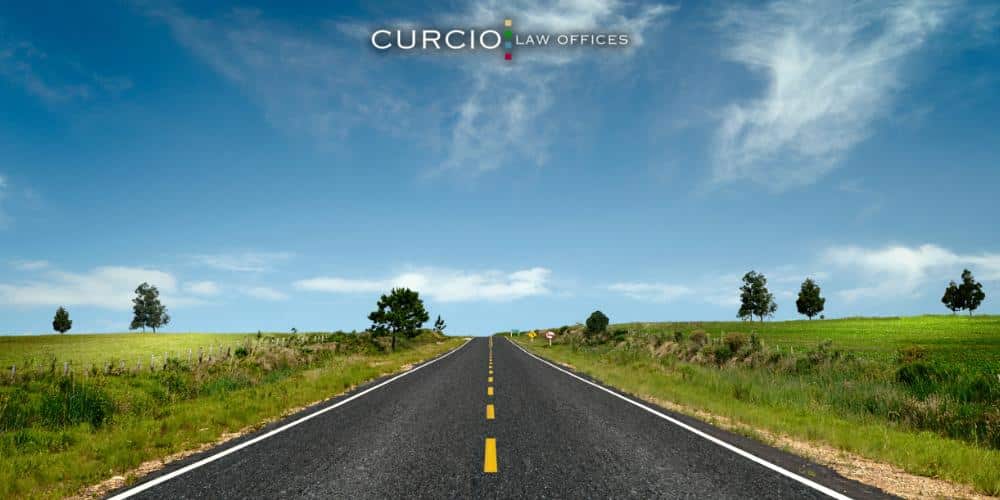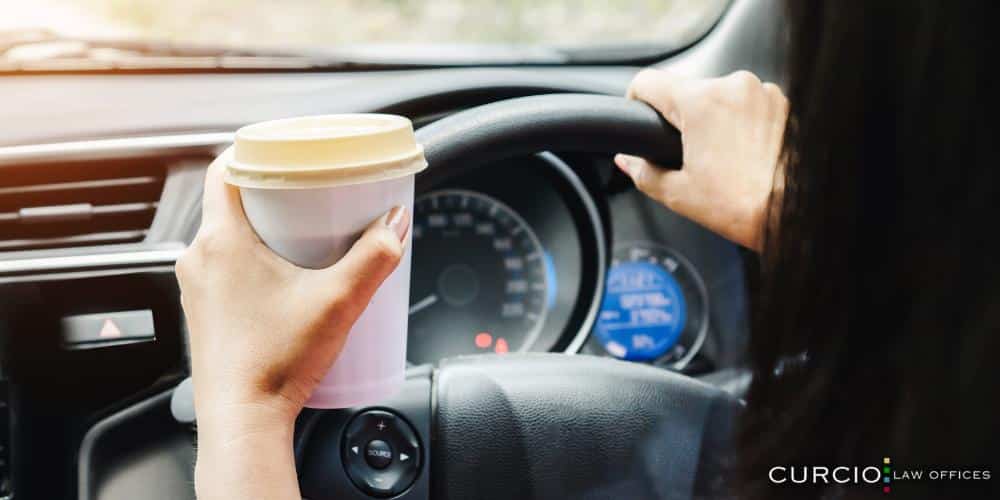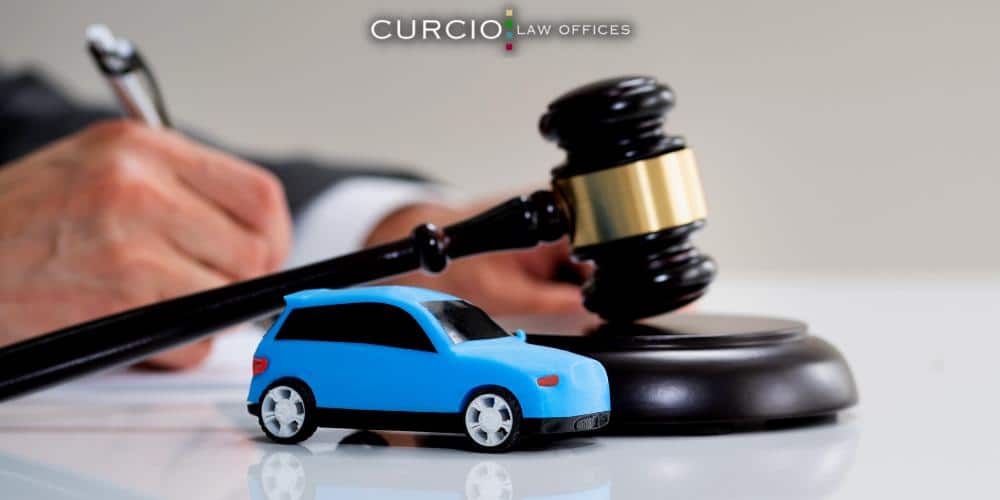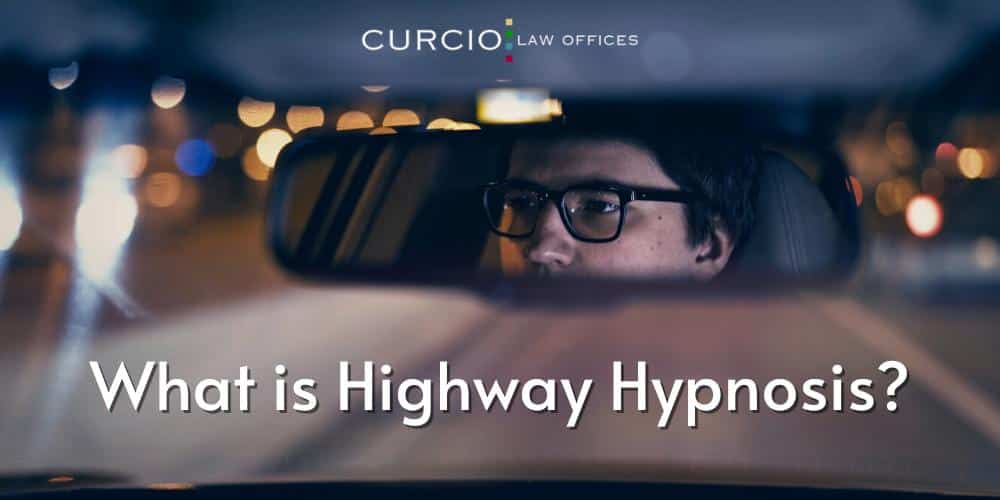Have you ever pulled in your driveway after a long day of work and realized that you don’t remember anything from your drive home? For all you know, you could have run traffic lights, forgotten turn signals, exceeded the speed limit, and ignored road signs, but you wouldn’t know because your memory of the last 30-or-so minutes is blank. This is called highway hypnosis, and it’s something we have all experienced before, especially on endless stretches of highway. Basically, it happens when you go into a trancelike state during a monotonous drive, and you’re functioning completely off of procedural memory and hyper focused automatic attention. Below, we explain everything you need to know about this common phenomenon – why does highway hypnosis happen? What are signs of highway hypnosis? And finally – how can you avoid highway hypnosis?
At Curcio & Casciato, our experienced Chicago personal injury attorneys are passionate about fighting for the justice of drivers injured by those who are driving drowsy or distracted. Call a Chicago car accident lawyer at 312-321-1111 today.
What is Highway Hypnosis?
We have all experienced highway hypnosis at one time or another. Highway hypnosis, also known as white line fever, is when you drive a vehicle while in a trance-like state. You’re awake and safely responding to external stimuli on the road, like using your turn signal and switching lanes, but you have no memory of doing so. This is a very common occurrence on long, monotonous roads or on your normal path home from work.
According to registered psychotherapist Natacha Duke, highway hypnosis is related to drowsy driving or distracted driving, but it’s not the same thing. In both drowsy and distracted driving, people are in a less alert mode and therefore have decreased reaction times. However, experts believe that driving hypnosis results in an increased level of automatic attention and the same reaction time as if they were not in a hypnotic state.
What Does Highway Hypnosis Feel Like?
You usually don’t realize you’re experiencing highway hypnosis until you get home and realize that you don’t remember your drive home from work, or you don’t remember where the last 20 miles went on the highway. You may also be experiencing highway hypnosis if you feel sleepy, dazed, mentally foggy, or like you can’t concentrate. Also, if your mind is wandering off about anything other than the road in front of you, this is a classic sign of road hypnosis as well.
If you’re a passenger in a vehicle, you may be able to notice the following warning signs of highway hypnosis in your driver:
- Glassy-eyed stare
- Swerving off into the rumble strip on the road
- Frequent blinking or heavy eyelids
- Slow reaction time
- Blank expression
If you notice these signs in your driver, do what you can to keep them focused behind the wheel.

Why Highway Hypnosis Happens
So – why does highway hypnosis happen? What’s the science and psychology behind this trance-like state?
Highway hypnosis happens when your brain switches to “auto pilot mode” and begins using a combination of procedural memory and hyper focused automatic attention.
Procedural memory is a type of long term memory that allows you to do a task with little to no effort, because you’ve been doing it for years and it’s become almost mindless. Examples of tasks that can be done with procedural memory include tying shoelaces, riding a bike, and, you guessed it, driving. It’s very similar to doing something from muscle memory alone.
Now, hyper focused automatic attention – this means that your eyes are locked on the road ahead of you, and you’re alert. Automatic attention is a type of attention process that is involuntary, effortless, and unintentional. This type of attention can allow you to zone out but still pay attention and respond automatically to what’s in front of you.
Drivers are more likely to experience highway hypnosis due to monotony and boredom, brain inattention, and fatigue.
Monotony and Boredom
You are most likely to switch into hyper focused automatic attention mode when driving down a monotonous stretch of highway or down a familiar path to and from work. There isn’t much mental predictability or energy required in these types of driving situations. On a long stretch of highway especially, you tend to turn on your car’s cruise control so you really don’t have to do anything other than sit there, hold onto the steering wheel, and keep an eye out for potential hazards. This is boring after a while, so you drift off into your thoughts.
Brain Inattention
Existing research from 2004 indicates that the oculomotor system that controls eye movements, also contributes to highway hypnosis. When you drive down a monotonous road for more than an hour, you’re basically staring at scenery that doesn’t really change, aside from the occasional passing car. In this situation, your brain relies less on what you’re actually seeing (retinal feedback) and more on mental predictions of what you’ll see (extra retinal feedback). Your brain alertness essentially decreases, and as a result, you pay less attention to visual stimuli on the road in front of you.
Fatigue
As previously stated, highway hypnosis and drowsy driving are different. Drowsy driving is very dangerous because you can fall asleep and crash. During highway hypnosis, you’re still awake and alert. It’s not necessarily dangerous because if a car were to suddenly pull out in front of you, you would snap out of the trance and take action. It just might take longer for you to do so compared to if you weren’t experiencing highway hypnosis.
But driver fatigue definitely raises the chances of highway hypnosis occurring, and can definitely create a dangerous situation on the roads.
How to Snap Out of Highway Hypnosis
Combined with distracted and drowsy driving, highway hypnosis contributes to thousands of crash injuries and deaths every year in the United States. It’s important to do what you can to snap out of a state of highway hypnosis if you notice it happening. You can do this by following the tips below.

Take a Coffee Break
Driving down a long boring road for an extended period is one of the top reasons why highway hypnosis occurs in the first place. So it’s important to take frequent breaks on long road trips to stretch your legs, get some fresh air, and have a change of scenery. Additionally, caffeine helps you stay awake and alert, so grab some coffee while you’re taking a break.
Sing or Talk
It’s harder to “zone out” when you’re actively talking to someone or singing to upbeat music. If you don’t have a passenger or you’re tired of your current Spotify playlist, call a friend or family member and catch up with them. You can even talk to yourself – no one is around to judge.
Change the Environment
You can’t really change the scenery of the long boring road ahead of you, but you can make environmental changes to the inside of your car to make yourself feel more mentally alert.
Roll down the window to let in warm air and the loud wind buffering noise, or turn down the air conditioning to make yourself a little chillier. Find an upbeat Spotify playlist, turn up the music, and sing along. If you’re slouching or laying back a bit in your chair, straighten up and maintain good posture. Sip on a fun and/or caffeinated drink. Lastly, turn off cruise control in your car which will force you to do more than just sit there and hold the steering wheel.
All of these things can break up the monotony of a long road trip and appeal to one or more of your senses, therefore keeping you present and focused.
How to Prevent Highway Hypnosis on a Long Road Trip
Fatigue, distraction, and boredom are the main contributing factors to road hypnosis. Below, we break down some of the best ways to avoid entering a trance-like state so that you can drive safely.
Drive Down New Roads
If you’ve been zoning out a lot lately while driving to work or to school, it’s likely because you know your current driving route so well that you don’t really need much brain alertness to get to your destination. Try taking a different route or highway exit than normal to switch things up and keep your brain from zoning out.

Make a New Playlist
Listening to the same old playlists day after day can add to the monotony of your daily commute. Slow music can also make you feel tired, especially early in the morning or late at night. Switch it up, make a new playlist of songs you can jam to, safely, behind the wheel.
Avoid Heavy Meals
If you know that large, heavy meals can make you feel extra sleepy, be sure to eat light while you’re on a long road trip to avoid falling asleep behind the wheel.
Get 8 Hours of Sleep
It’s safe to say that most Americans are running on far less sleep than we actually need in order to keep up in our fast-paced society. This can be a recipe for disaster on a long drive, though. Be sure to get a good night’s sleep before hitting the road to avoid road hypnosis and fatigued driving.

Call Chicago Car Accident Lawyers at Curcio & Casciato Today
If you or someone you love suffered catastrophic injuries or wrongful death in a car accident caused by a drowsy or distracted driver, you may have grounds to take legal action. Our Chicago catastrophic injury lawyers and Chicago wrongful death lawyers at Curcio & Casciato have recovered more than $10 million in combined car accident settlements for our injured clients. Allow our experienced legal team to fight for your legal rights and justice. Call 312-321-1111 to schedule a free consultation at Curcio & Casciato today.



